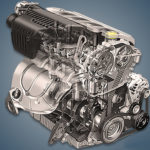3.0-liter 24-valve Renault L7X engine was introduced in 1997, when a line of V6 engines called ESL replaced the outdated PRV. This engine was installed on such Renault models as Safrane, Espace, Laguna and Clio V6.
In 1997, a successor to the popular French V6 type PRV was introduced. The engine was developed and assembled by the joint efforts of Renault and Peugeot-Citroen engineers at the same plant in the city of Douvrin. The new unit was completely made of aluminum, with a characteristic camber angle of 60 degrees for V-shaped sixes, and not 90 like its predecessor.
This time, many versions were not fenced, the engine was produced only in a 3.0-liter 24-valve version with 194 hp. For Peugeot-Citroen models, a special modification was made with a phase regulator at the inlet of 207 and 211 hp.
Standing apart from everyone is one of the hottest compact hatchbacks of the time, the Clio V6. Huge for such a small car, the power unit was placed instead of the rear seats. As a result of a small tuning, its power was 230 hp, and after restyling in 2003, all 255 hp.
Specifications
| Production years | since 1997 |
| Displacement, cc | 2946 |
| Fuel system | injector |
| Power output, hp | 190 – 194 230 – 255 (Clio) |
| Torque output, Nm | 267 300 (Clio) |
| Cylinder block | aluminum V6 |
| Block head | aluminum 24v |
| Cylinder bore, mm | 87 |
| Piston stroke, mm | 82.6 |
| Compression ratio | 9.6 11.4 (Clio) |
| Hydraulic lifters | yes |
| Timing drive | belt |
| Phase regulator | since 2000 |
| Turbocharging | no |
| Fuel type | petrol |
| Euro standards | EURO 3/4 |
| Engine lifespan, km | ~300 000 |
| Weight, kg | 200 |
Disadvantages of the Renault L7X engine
- Since the engine has several revisions, its ignition system is slightly different: in one case, six individual coils, and in the other, a triple block with six leads. However, engine tripping is most often associated with coils, regardless of performance.
- An unreliable thermostat and air pockets in the cooling system are often the cause of overheating of the motor. Carefully monitor the readings of the instruments, as the control unit quickly fails from high temperatures.
- Owners are often overcome by minor breakdowns in the electrical part. In the vast majority of cases, this is due to the fault of either an oxidized terminal, or a chip that has fallen out of the connector.






